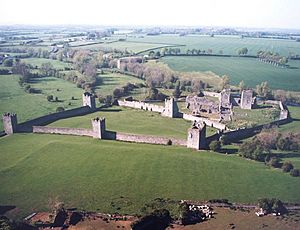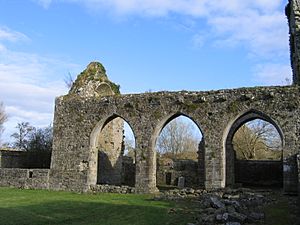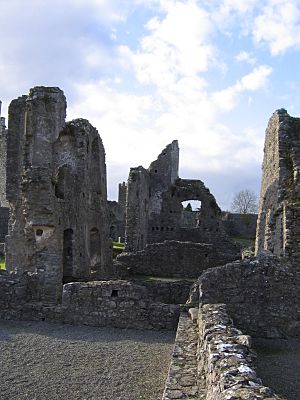Kells Priory facts for kids
| Prióireacht Cheanannais | |

Kells Priory
|
|
| Monastery information | |
|---|---|
| Order | Augustinians |
| Established | 1193 |
| Disestablished | 1540 |
| People | |
| Founder(s) | Geoffrey FitzRobert |
| Architecture | |
| Heritage designation | National Monument |
| Site | |
| Location | Kells, County Kilkenny, Ireland |
| Coordinates | 52°32′18″N 7°16′01″W / 52.53833°N 7.26694°W |
| Public access | No |
| Official name | Kells Priory |
Kells Priory (Irish: Prióireacht Cheanannais) is one of the biggest and most impressive old buildings in Ireland. It's a medieval (Middle Ages) monument.
This Augustine priory is a type of monastery run by Augustinian monks. It sits next to the King's River, near the village of Kells. The priory is a National Monument, which means it's a very important historical site protected by the government.
One cool thing about Kells Priory is its many medieval tower houses. These towers are built into the walls around the site, which is about the size of three football fields. They make the priory look more like a fortress than a place of worship. Because of these towers, locals sometimes call it "Seven Castles."
About 4 kilometers southeast of the priory, you can find the Kilree round tower. There's also a 9th-century High Cross there. This area was even used as a filming location for the movie Barry Lyndon.
Contents
History of Kells Priory
Kells Priory was started by Geoffrey FitzRobert in the year 1193. Geoffrey was related to a powerful Norman knight named Strongbow. The priory was built on the site of an older church that was dedicated to St. Mary. This church used to serve the nearby village of Kells.
Attacks and Fortifications
During its first 150 years, the priory faced many challenges. It was attacked and burned three times!
- First, by Lord William de Bermingham in 1252.
- Then, by the Scottish army led by Edward Bruce in 1326.
- And again, by another William de Bermingham in 1327.
Because of these attacks, it's very likely that the strong walls and towers you see today were built during this time. They helped protect the monks and the priory from harm.
A Bishop's Imprisonment
In 1324, the Bishop of Ossory, Richard de Ledrede, visited the priory. He was investigating some people in Kilkenny. The Bishop ordered two people, Alice Kyteler and William Outlawe, to appear before him. However, William Outlawe was supported by Arnold de Paor, who was the Lord of Kells. Arnold de Paor actually arrested the Bishop and held him in Kilkenny Castle for 17 days!
This event caused a big scandal. After he was released, the Bishop continued his investigations. Alice Kyteler managed to escape to England.
End of the Priory
The priory eventually closed down in March 1540. This happened during a time called the Dissolution of the Monasteries. During this period, many monasteries in Ireland and England were closed by the government. The church and its property were then given to James Butler, who was the 9th Earl of Ormonde.
Layout of the Priory
The priory is split into two main parts.
- The inner monastic Precinct is right next to the river. This is where the monks lived and worshipped.
- The outer enclosure is a larger area to the south. In the 1400s, this part was called Villa Prioris. Today, it's often known as Burgher's Court or Burgess Court.
The name "Burgess Court" is used because it shows what this area was for. People used to think it was a medieval town, but modern research shows it was part of the priory. Today, all the old monastic buildings are in the Precinct. Burgess Court is mostly just a walled field where tourists visit and sheep graze.
Discoveries from Excavations
Archaeologists have done a lot of work at Kells Priory. Tom Fanning, a state archaeologist, started digging at the site in 1972. After he passed away in 1993, Miriam Clyne finished his work. This excavation was one of the biggest ever done at a monastic site in Ireland. The detailed report about their findings is also one of the largest ever published about a medieval rural site.
During the digs, archaeologists found about 20,000 items! These included:
- Pieces of carved stone
- Different kinds of pottery
- Floor and roof tiles
- Metal objects
- Even pieces of painted window glass!
The window glass was very special because it allowed experts to figure out what some of the priory's beautiful stained-glass windows might have looked like. The original church at the priory was a simple cross shape. But over time, it was made much bigger, with new sections added in almost every direction.
Images for kids












